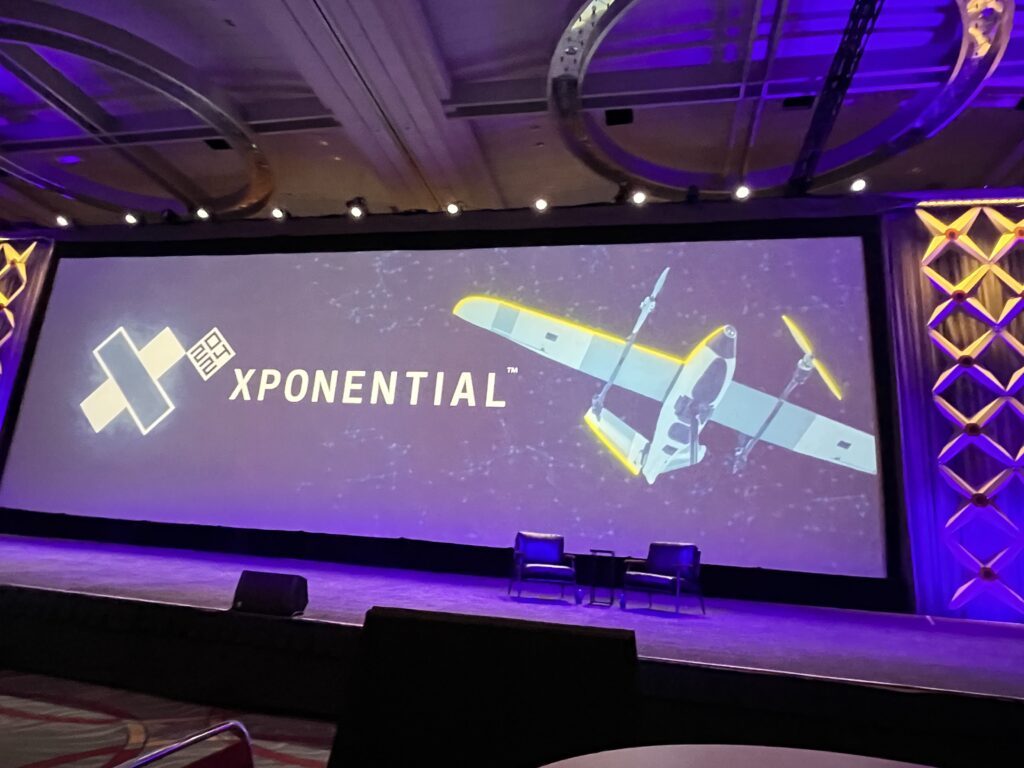 Keynote Sets Tone for New Leadership
Keynote Sets Tone for New Leadership
- AUVSI plans to launch “Robot Ready” Campaign in 2025.
- Michael Brasseur (USN Ret.), Chief Strategy Officer at Saab Inc., and Aaron Pierce, CEO of Pierce Aerospace, have been added to AUVSI’s board of directors.
- S. CENTCOM has stood up 3 autonomy-focused units: NAVCENT Fleet 59 (maritime); AFCENT Task Force 99 (air) and ARCENT Task Force 39 (ground).
- Saab announced Skapa by Saab, a collaborative space for innovators to create, make and shape the future of defense and security.
By: DRONELIFE Contributor Dawn Zoldi (Colonel, USAF Ret.)
The opening keynotes generally set the tone for an event. This year at AUVSI‘s XPONENTIAL, John “JC” Coffey, AUVSI Board of Directors member and Executive Director of Uncrewed Systems at Cherokee Nation Federal, kicked off the week on the keynote stage in San Diego by emphasizing the transformative power of autonomy. “Novel problems, technologies, and grand ideas often converge to propel us forward,” he said. Given the current state of the world, with issues from Ukraine, the Red Sea, Israel, Syria and Jordan to the South China Sea, it’s no wonder that the focus in this opener revolved largely around defense. We have seen the profound impact that intelligent bots and algorithms have had on productivity and safety have had across a range of sectors. The defense community, and its industrial partners, help to drive innovation autonomy in support of the warfighter. AUVSI, with its newly appointed President and CEO, Michael Robbins, a U.S. Navy Reservist, plans to place additional emphasis on assisting defense while bolstering the commercial autonomy community.

 AUVSI Runs Towards Friction
AUVSI Runs Towards Friction
In his Community Address Robbins underscored AUVSI’s role as both a membership and trade association that caters to the needs of the commercial, defense, air, ground, maritime, AI, space, and cybersecurity sectors. He highlighted the exponential (pun intended) growth of these advocacy partnerships in recent years and emphasized the association’s commitment to tangible progress over mere activity, encapsulated in his mantra “movement over motion.”
In elaborating on his vision grounded in attentive listening and proactive engagement, Robbins outlined the association’s key initiatives that have assisted in advancing autonomy across various domains, from the development of draft rules for beyond visual line of sight (BVLOS) operations in the air domain, progress on risk-based waivers, the launch of both Drone Prepared and AAM Prepared, the Green UAS program and Drone Competitiveness Campaign (which he vowed to expand to manufacturing-focused advocacy in both the ground and marine domains) and efforts to overcome the funding and public perception challenges facing ground autonomy. On this front, Robbins announced the upcoming launch of a “Robot Ready Campaign” sometime next year and his goal to put ground autonomy in “sharper focus.” Additionally, he addressed the critical importance of safety, security and diversity within the industry, highlighting the establishment of cyber working groups and partnerships to bolster defense capabilities and global competitiveness while mitigating reliance on Chinese supply chains.
On this last topic, Robbins acknowledged that AUVSI’s efforts to “level the playing field against the People’s Republic of China (PRC)” have “understandably unsettled some,” but nevertheless reemphasized AUVSI’s commitment to diversifying supply chains beyond China remains “unwavering.”
“We are only going to support common sense programs that will level the playing field,” Robbins said. By “kickstarting the flywheel,” AUVSI aims to mitigate risks and bolster the Defense Industrial Base (DIB) for all stakeholders, he continued, with particular emphasis on fortifying defense capabilities.
Robbins ended his address with a call to action, expressing gratitude for the opportunity to lead AUVSI in its mission to navigate friction and facilitate collaborative solutions that ensure the safe and secure integration of uncrewed systems. “Thank you for this opportunity to lead this organization,moving towards friction and solving problems for you,” he concluded.
In related AUVSI news front the stage, Coffee in his opening, introduced two new board members, Michael Brasseur, a retired Naval officer with a background in the Navy’s pioneering robotics initiatives and currently the Chief Strategy Officer at Saab Inc., and Aaron Pierce, CEO of Pierce Aerospace, with a long history in leading aerospace advancements in the defense sector. These new additions to the Board seem to underscore AUVSI’s commitment to the type of innovation and collaboration that will drive the uncrewed systems industry into the future.

 Central Command Innovates in Action
Central Command Innovates in Action
U.S. Central Command (CENTCOM) stands at the forefront of innovation in autonomy within the Department of Defense (DOD), adapting to the evolving landscape where uncrewed systems are rapidly proliferating worldwide and the boundaries between defense and commercial technologies are becoming increasingly blurred. The operational scope of U.S. CENTCOM covers over 4 million square miles, stretching from Northeast Africa across the Middle East to Central and South Asia. This vast area is home to over 560 million people belonging to 25 ethnic groups, speaking 20 languages with numerous dialects, and practicing multiple religions that cross national boundaries.
Vice Admiral Brad Cooper, the USN Deputy Commander of CENTCOM, beaming in on a large jumbotron from his headquarters in Tampa, Florida, said his leadership team has placed a strategic emphasis on leveraging uncrewed systems and counter-Unmanned Aircraft Systems (C-UAS) capabilities. In the Middle East theater, CENTCOM has been deploying uncrewed systems for command and control (C2) operations, including airborne Unmanned Aerial Systems (UAS) for over four decades. These advanced technologies enable more effective application of combat power, with improved collection, strike capabilities and risk mitigation. This leads to more timely and accurate decisions while reducing risks to the force. From mid to high altitude RPAS (Remotely Piloted Aircraft Systems) to hand-launched small UAS used by tactical units, these systems collectively provide Intelligence, Surveillance, and Reconnaissance (ISR), targeted strikes, and Force Protection (FP).
CENTCOM created three specific task forces to harness uncrewed innovation for the warfighter, Cooper explained. NAVCENT Fleet 59 focuses on maritime uncrewed and remotely piloted fast attack craft. These enhance maritime domain awareness and security through optimized decision-making with integrated AI. AFCENT Task Force 99 addresses operational gaps for its aircentric mission with these systems, while ARCENT Task Force 39 has used autonomous ground vehicles, such as large Autonomous Vehicle Systems (AVS), to establish a robust logistics network to sustain US forces. ARCENT, Cooper said, has also been experimenting with additive manufacturing for rapid replacement of autonomous parts and to counter mine threats.
Looking ahead, CENTCOM aims to integrate even more advanced technologies into future operations, including accompanying autonomous aircraft with next-gen dominance aircraft for air defense suppression and lethality delivery, as well as sustaining air and maritime fights through autonomous logistics operations. This transition is already underway.
Cooper characterized CENTCOM’s commitment to operationalization of commercial tech through real world deployment, iteration and real-world feedback to enhance capabilities swiftly. CENTCOM’s future focus is on achieving faster, longer-range capabilities capable of carrying diverse payloads and deploying multiple sensors. To do this, CENTCOM continues forging partnerships with industry and academia to harness the full potential of autonomous vehicles. These partnerships extend far beyond the battlefield effects and into a future of enhanced operational effectiveness for both the military and the commercial sectors.

 Saab Transforms Military Tech
Saab Transforms Military Tech
For its part, Saab Inc., under the leadership of Chief Strategy Officer Michael Brasseur (AUVSI’s new Board Member) spearheads groundbreaking innovation in autonomy, robotics and AI that transcends traditional defense sector boundaries. In his portion of the keynote, Brasseur reflected on the rich history of uncrewed systems, robotics, and autonomy which had their origins in defense sector research, development, testing and evaluation (RDT&E) and subsequently expansion into commercial and civil sectors. Saab continues this work today.
Brasseur highlighted Saab’s vision to transform the very nature of maritime operations, noting that “our journey is far from complete.” He emphasized that Saab’s commitment remains to rapidly deliver cutting-edge technology to meet the evolving needs of military personnel. “Our North Star is to deliver the tech our troops need as fast as possible…The gap between identifying a need and employment could make the difference between dominance and obsolescence,” he warned.
Recognizing the critical importance of closing such a gap, especially in the Pacific theater, Saab continues to rethink its approach to national security with a holistic co-development strategy alongside operators. This approach encompasses not only technological advancements but also innovations in production, materials and business models. Consistent with this approach, from the stage, Brasseur announced Saab’s latest endeavor, Skapa by Saab, a collaborative space for innovators to create, make and shape the future of defense and security.
As did Cooper before him, Brasseur stressed the importance of collaboration in addressing the challenges faced by military personnel directly. Saab’s commitment to this approach, he said, can be evidenced by projects like Enforcer 3, a 53-foot boat equipped with advanced radar and autonomy capabilities, designed to enhance maritime security.
Through initiatives like Skapa and projects like Enforcer 3, Saab aims to pioneer the next generation of defense technologies and empower end-users with smarter, more capable solutions built on collaboration and innovation.
A Pivot to Defense?
These keynote presentations left many conference attendees and exhibitors with the lingering question as to whether this emphasis on the defense sector signals a significant pivot for AUVSI, going forward and if, so, where do they fit into the picture.
Many commercial companies see the DOD as a potential lifeline, in an era of shrinking venture capital funding and limited regulatory guidance for the types of complex operations needed to scale the uncrewed industry. It remains to be seen whether or not that is actually the case.
Even so, morale seemed high as attendees funneled out of the keynotes and into an XPO Hall packed with a wide range of technology across the autonomy ecosystem. The energy and excitement on the floor was palpable as industry participants connected – or reconnected – with each other across the sprawling show floor at another successful XPONENTIAL.
Read more:

 Dawn M.K. Zoldi (Colonel, USAF, Retired) is a licensed attorney with 28 years of combined active duty military and federal civil service to the U.S. Air Force. She is the CEO & Founder of P3 Tech Consulting and an internationally recognized expert on uncrewed aircraft system law and policy. Zoldi contributes to several magazines and hosts popular tech podcasts. Zoldi is also an Adjunct Professor for two universities, at the undergraduate and graduate levels. In 2022, she received the Airwards People’s Choice Industry Impactor Award, was recognized as one of the Top Women to Follow on LinkedIn and listed in the eVTOL Insights 2022 PowerBook. For more information, follow her on social media and visit her website at: https://www.
Dawn M.K. Zoldi (Colonel, USAF, Retired) is a licensed attorney with 28 years of combined active duty military and federal civil service to the U.S. Air Force. She is the CEO & Founder of P3 Tech Consulting and an internationally recognized expert on uncrewed aircraft system law and policy. Zoldi contributes to several magazines and hosts popular tech podcasts. Zoldi is also an Adjunct Professor for two universities, at the undergraduate and graduate levels. In 2022, she received the Airwards People’s Choice Industry Impactor Award, was recognized as one of the Top Women to Follow on LinkedIn and listed in the eVTOL Insights 2022 PowerBook. For more information, follow her on social media and visit her website at: https://www.
Miriam McNabb is the Editor-in-Chief of DRONELIFE and CEO of JobForDrones, a professional drone services marketplace, and a fascinated observer of the emerging drone industry and the regulatory environment for drones. Miriam has penned over 3,000 articles focused on the commercial drone space and is an international speaker and recognized figure in the industry. Miriam has a degree from the University of Chicago and over 20 years of experience in high tech sales and marketing for new technologies.
For drone industry consulting or writing, Email Miriam.
TWITTER:@spaldingbarker
Subscribe to DroneLife here.
